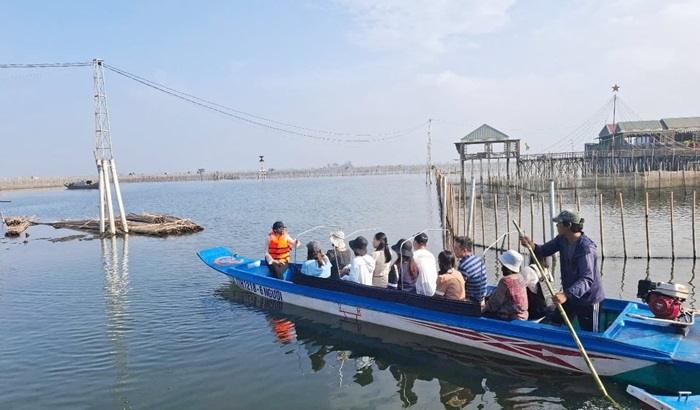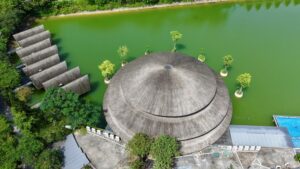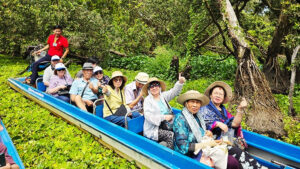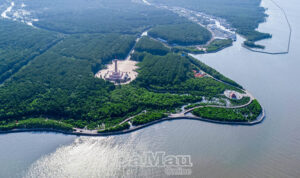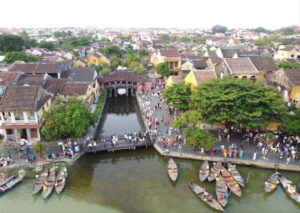Vietnam is one of the 13 countries that have tigers in the wild, yet it is facing an urgent challenge in protecting the species, which is being pushed to the brink of extinction due to economic and social pressures.
 A 2011 survey by the Institute of Ecology and Biological Resources showed that the number of wild tigers in Vietnam fell sharply, with between 27 – 47 individuals, recorded mainly in the Muong Nhe Nature Reserve, and the Pu Mat, Vu Quang, Chu Mom Ray and Yok Don national parks. The main reason behind the situation is the poaching and illegal trading of tigers and their prey, which have yet been controlled by authorised agencies. The big cat’s natural habitat is dwindling seriously due to men’s acts of cutting down forests for cultivable land, hydro-power plants, infrastructure, and mining. It is reported that natural forests have shrunk from 43 percent of Vietnam’s land area in late 20th century to 17 percent at present. Since the 1960s, the country was aware of the importance of conserving wildlife, adopting an ordinance to ban the hunt of wild animals. It added tigers along with many other species to the list of those in need of protection and summoned numerous resources for the work. However, a host of problems remain, hindering efforts to save the big cat, so are different viewpoints from national to international scales on how to conserve it. Many foreign experts argued the breeding of tigers is detrimental to conservation efforts and may fuel the illegal trading of the species. Meanwhile, others consider the activity an effective way to provide the gene pool to multiply the species’ population in the wild. Several scientists viewed the conservation of tigers in the wild an important factor in protecting biodiversity while some others approached the issue with an idea that the work should be focused completely on biodiversity, not a single species. While differences in viewpoints are still there, there are no in-depth researches on wild tigers as well as specific reserves for the species in the country. Overlapping regulations, a shortage of strict punishments on tiger trading, and the laxity in domestic and international cooperation have also hampered the conservation. Meanwhile, long-term, large scale communication campaigns remained absent and conservation programmes have yet paid due attention to the involvement of local communities. To alter the situation, on April 16, 2014, Prime Minister Nguyen Tan Dung issued a decision approving a national programme on tiger conservation from 2014 to 2022, which is seen as a comprehensive approach and a long-run programme in the field. Accordingly, building a programme monitoring wild tigers, their prey as well as the breeding of this species will be a must and advanced technologies such as geographic information system (GIS) and scanning radars are believed to help out. The country is also required to intensify the clampdown on illegal trading of wild fauna and flora, improve personnel capacity, and encourage the community’s engagement in the work. Heavier investments and closer cooperation with other countries, especially the neighbouring ones, are crucial to saving the big cat in a sustainable way./.
A 2011 survey by the Institute of Ecology and Biological Resources showed that the number of wild tigers in Vietnam fell sharply, with between 27 – 47 individuals, recorded mainly in the Muong Nhe Nature Reserve, and the Pu Mat, Vu Quang, Chu Mom Ray and Yok Don national parks. The main reason behind the situation is the poaching and illegal trading of tigers and their prey, which have yet been controlled by authorised agencies. The big cat’s natural habitat is dwindling seriously due to men’s acts of cutting down forests for cultivable land, hydro-power plants, infrastructure, and mining. It is reported that natural forests have shrunk from 43 percent of Vietnam’s land area in late 20th century to 17 percent at present. Since the 1960s, the country was aware of the importance of conserving wildlife, adopting an ordinance to ban the hunt of wild animals. It added tigers along with many other species to the list of those in need of protection and summoned numerous resources for the work. However, a host of problems remain, hindering efforts to save the big cat, so are different viewpoints from national to international scales on how to conserve it. Many foreign experts argued the breeding of tigers is detrimental to conservation efforts and may fuel the illegal trading of the species. Meanwhile, others consider the activity an effective way to provide the gene pool to multiply the species’ population in the wild. Several scientists viewed the conservation of tigers in the wild an important factor in protecting biodiversity while some others approached the issue with an idea that the work should be focused completely on biodiversity, not a single species. While differences in viewpoints are still there, there are no in-depth researches on wild tigers as well as specific reserves for the species in the country. Overlapping regulations, a shortage of strict punishments on tiger trading, and the laxity in domestic and international cooperation have also hampered the conservation. Meanwhile, long-term, large scale communication campaigns remained absent and conservation programmes have yet paid due attention to the involvement of local communities. To alter the situation, on April 16, 2014, Prime Minister Nguyen Tan Dung issued a decision approving a national programme on tiger conservation from 2014 to 2022, which is seen as a comprehensive approach and a long-run programme in the field. Accordingly, building a programme monitoring wild tigers, their prey as well as the breeding of this species will be a must and advanced technologies such as geographic information system (GIS) and scanning radars are believed to help out. The country is also required to intensify the clampdown on illegal trading of wild fauna and flora, improve personnel capacity, and encourage the community’s engagement in the work. Heavier investments and closer cooperation with other countries, especially the neighbouring ones, are crucial to saving the big cat in a sustainable way./.


